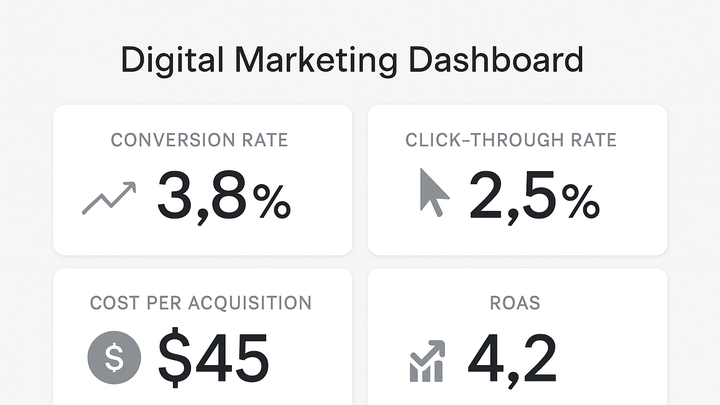Published on 2025-06-29T19:22:57Z
What is a Key Performance Indicator (KPI)? Examples for Campaign Tracking & Analytics
Key Performance Indicators (KPIs) are quantifiable metrics used to evaluate the success of marketing campaigns and digital initiatives within campaign tracking & analytics. They offer a clear measurement of performance against specific objectives, such as increasing website traffic, boosting conversions, or improving return on ad spend. By focusing on a finite set of KPIs, marketers can prioritize the most impactful data, avoid analysis paralysis, and drive strategic decisions. KPIs can range from high-level business outcomes like revenue growth to granular digital metrics like click-through rate or cost per acquisition. Tools such as Plainsignal enable cookieless tracking of user interactions, while UTMguru streamlines the creation and management of UTM-tagged URLs to accurately attribute traffic. Monitoring KPIs regularly helps identify trends, optimise campaign performance, and align future marketing strategies with business goals. Consistent review and adjustment of KPIs, following SMART criteria, ensure they remain relevant and actionable over time.
Key performance indicator (kpi)
Quantifiable metrics that gauge the success of marketing campaigns in campaign tracking & analytics.
Understanding Key Performance Indicators (KPIs)
KPIs are measurable values that demonstrate how effectively marketing efforts are achieving key business objectives. They provide a focused view of performance by isolating the most critical metrics from a wealth of data. Well-defined KPIs serve as a compass, guiding campaign decisions, resource allocation, and strategic planning. In campaign tracking & analytics, KPIs translate broad goals into specific, measurable targets that teams can monitor and optimize in real time.
-
Definition
A KPI is a quantifiable metric that reflects the performance of a campaign against a predefined objective.
-
Purpose
KPIs focus attention on the most important measures, enabling informed decision-making and clear progress tracking.
-
Characteristics of effective kpis
Effective KPIs possess clear attributes that make them actionable and aligned with business goals.
- Specific:
Clearly defined and unambiguous about what is being measured.
- Measurable:
Quantifiable so progress can be tracked against a numeric value.
- Achievable:
Realistic targets that challenge the team but are attainable.
- Relevant:
Aligned with broader business objectives and campaign goals.
- Time-bound:
Bound by a clear timeframe for evaluation and accountability.
- Specific:
Examples of KPIs in Campaign Tracking
Various metrics serve as KPIs in digital marketing, each highlighting different aspects of campaign performance. Selecting the right KPIs depends on campaign goals, channel specifics, and the overall marketing strategy. Below are commonly used KPIs that teams monitor to gauge success.
-
Conversion rate
The percentage of visitors who complete a desired action, such as a purchase or sign-up.
-
Click-through rate (ctr)
The ratio of users who click on an ad or link compared to those who view it.
-
Cost per acquisition (cpa)
The average cost incurred to acquire a single customer or lead.
-
Return on ad spend (roas)
The revenue generated for every dollar spent on advertising.
Implementing KPIs with Plainsignal
PlainSignal offers a privacy-first, cookieless approach to analytics, enabling you to track key metrics without compromising user privacy. It captures essential data points that align with your KPIs and presents them in an intuitive dashboard. Below are steps to set up PlainSignal and monitor your KPIs effectively.
-
Setup tracking code
Insert the PlainSignal script into your website to start collecting data instantly. Example:
- Tracking code example:
<link rel="preconnect" href="//eu.plainsignal.com/" crossorigin /><script defer data-do="yourwebsitedomain.com" data-id="0GQV1xmtzQQ" data-api="//eu.plainsignal.com" src="//cdn.plainsignal.com/plainsignal-min.js"></script>
- Tracking code example:
-
Navigating the dashboard
View real-time KPI metrics such as visits, engagement events, and conversion triggers. Use filtering to analyze performance by campaign or time period.
Leveraging UTMguru for UTM Parameter KPIs
UTMguru simplifies the creation, generation, and management of UTM-tagged URLs, ensuring accurate attribution of traffic and campaign performance. By systematically tagging links, you can trace KPI outcomes back to specific marketing activities.
-
Generating utm urls
Use UTMguru’s builder to define campaign parameters (source, medium, campaign name) and generate the URL.
-
Saving and listing tags
Save frequently used parameter sets for quick reuse and maintain consistency across campaigns with the Chrome extension or web interface.
-
Attributing kpis to campaigns
Filter analytics dashboards by UTM parameters to isolate and compare KPI performance across different campaigns.
Best Practices for KPI Management
Effective KPI management requires ongoing review, clear alignment with goals, and adaptability. Employ the following best practices to maximize the impact of your KPIs.
-
Align with business goals
Ensure every KPI directly supports your overarching objectives and key strategic priorities.
-
Use smart criteria
Apply SMART principles to your KPIs for clarity and accountability.
- Specific:
Define precise objectives to avoid ambiguity.
- Measurable:
Choose metrics that can be quantitatively tracked.
- Achievable:
Set realistic targets informed by historical data.
- Relevant:
Link metrics to core business outcomes.
- Time-bound:
Assign timeframes to each KPI for timely assessment.
- Specific:
-
Review and iterate regularly
Monitor your KPIs frequently to detect trends, adjust strategies, and optimize performance.
-
Combine quantitative and qualitative data
Supplement numeric KPIs with qualitative feedback to gain full context on campaign impact.
